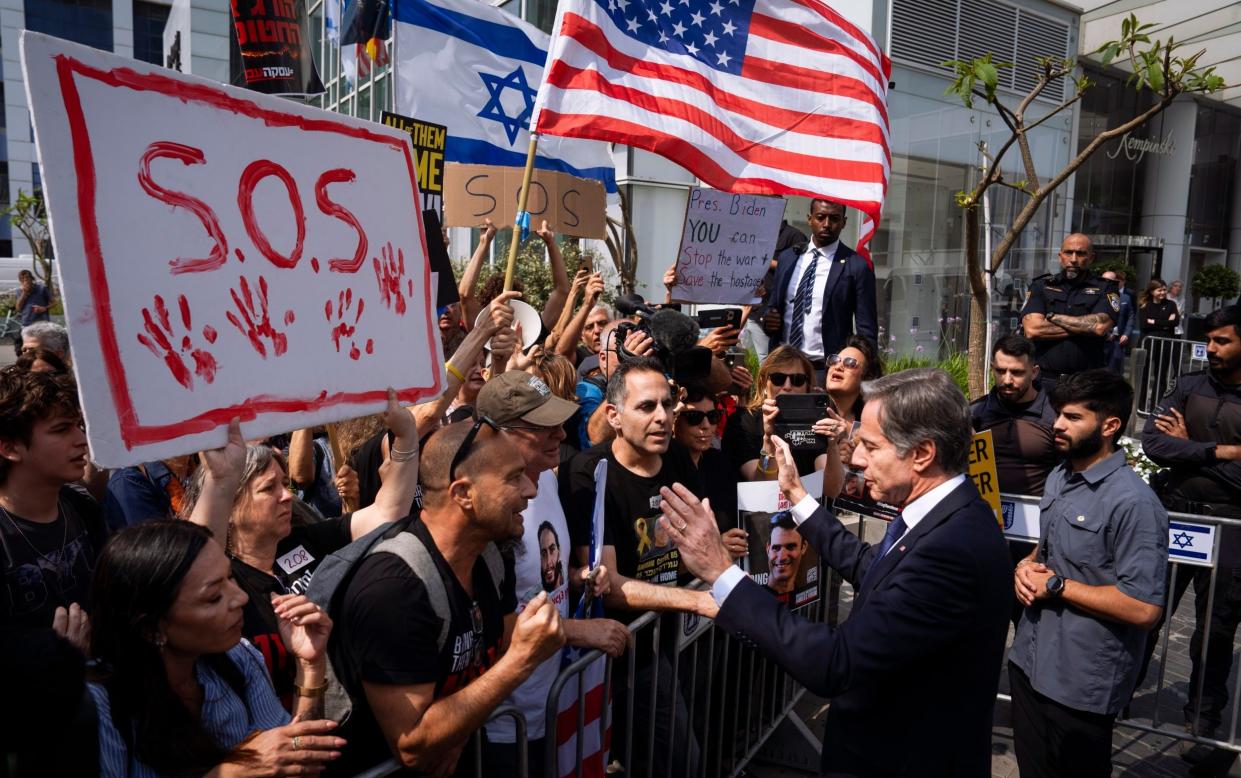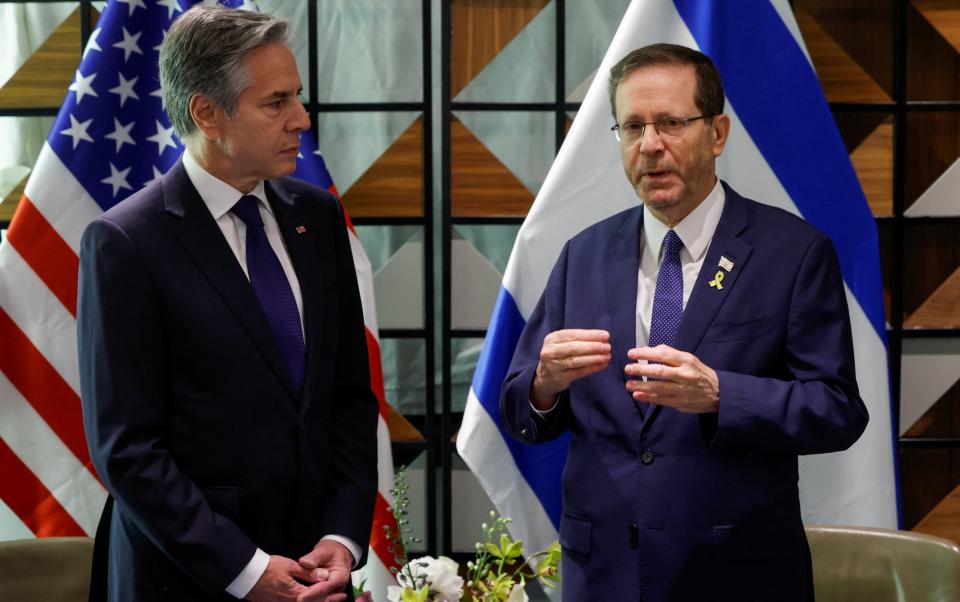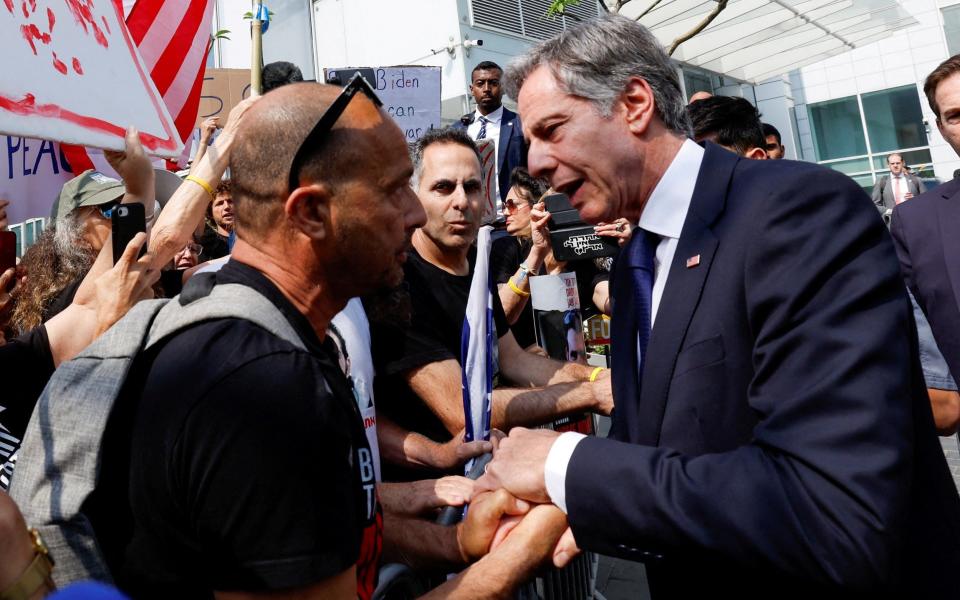Leaked Gaza ceasefire plans trigger backlash in Israel

- Oops!Something went wrong.Please try again later.
- Oops!Something went wrong.Please try again later.
Plans to negotiate a permanent ceasefire in Gaza have triggered a backlash in Israel, with members of Benjamin Netanyahu’s cabinet threatening to break up the government.
Leaked outlines of the hostage deal sent to Hamas include Israel committing to “sustainable calm” in the Gaza Strip, a phrase used to describe the end of previous conflicts.
Critics argue the commitment would mean Israel abandoning one of its principal war aims of defeating Hamas, a pledge made after the Oct 7 terror attacks.
Orit Strock, the hard-Right settlements minister, said Israel should not throw the war “in a trash bin” to “save 22 or 33 people – I don’t know how many”, referring to Israeli hostages held in Gaza.
Echoing her allies Bezalel Smotrich and Itamar Ben Gvir, who on Tuesday threatened to leave the governing coalition if the deal was approved, Ms Strock told army radio that Benjamin Netanyahu’s “government has no right to exist” if it accepted the agreement.
Speculation is rife that Israel will cancel its planned invasion of Rafah, the only big city in Gaza largely unaffected by fighting, if Hamas agrees to the deal.
Leaked parts of the deal propose a first-stage 40-days ceasefire, in which Hamas would release 33 vulnerable hostages. In exchange, Israeli forces in Gaza will cease fire and “allow the movement of humanitarian aid and the return of civilians to their homes”.
For every released hostage, Israel will release 20 Palestinian prisoners, a more generous offer than previous offers. Hamas will provide a list of the prisoners in Israeli jails it would like to receive but Israel will be able to veto them.
From Day 16 of the truce, Israel and Hamas are expected to begin talks with the aim of creating “sustainable calm” in Gaza, a euphemism for ending the war that suits the Israeli government, which has refused to publicly say it is willing to stop the war.

The first stage of the deal involves a staged withdrawal of Israeli troops from parts of the Strip in order to allow the movement of humanitarian aid and the return of civilians. The second stage of the deal will involve a complete withdrawal alongside a “sustainable calm”.
Mr Smotrich, the finance minister and one of the leaders of the Right-wing, warned late on Tuesday that committing to stop the fighting in Gaza and releasing “terrorists with blood on their hands” would be akin to “the surrender of the state of Israel”.
The opposition from Israel’s Right-wing came as Antony Blinken, the US Secretary of State, came to Israel on Wednesday to reaffirm Israel’s agreement to the deal at a pivotal moment for the 133 Israeli hostages abducted into Gaza and with a potential invasion of the southern city of Rafah looming.
Mr Blinken said Washington was “determined to get a ceasefire that brings the hostages home, and get it now”.
“The only reason that that wouldn’t be achieved is because of Hamas,” he said after meeting the president of Israel. “There is a proposal on the table. And as we’ve said: no delays, no excuses. The time is now.”

A Hamas spokesman on Wednesday criticised Mr Blinken’s comments, saying they were intended to put pressure on the group and absolve Israel of responsibility for the humanitarian crisis in Gaza.
Sami Abu Zuhri told Reuters the terrorist group was still studying the proposal.
Mr Blinken later on Wednesday sat down with Mr Netanyahu, the Israeli prime minister, in a private meeting in Jerusalem, with their respective staff.
During the meeting, which lasted about two-and-a-half hours, Mr Netanyahu told the visiting US official that he would not accept a deal that would include ending the war, US news site Axios reported.
With hopes running high in Israel of a breakthrough in the hostage negotiations, dozens of people rallied outside Mr Blinken’s hotel in Tel Aviv on Wednesday morning, urging him to get a deal done to free them.
The US Secretary of State came out to the protesters after one of his meetings, telling them Washington “will not rest until everyone – man, woman, soldier, civilian, young, old – is back home”.
“Hamas needs to say ‘yes’ and needs to get this done,” he told the crowds.

Mr Blinken also met the relatives of American or dual American citizens in Hamas captivity later on Wednesday.
Israel insists the war cannot end before it fully eradicates Hamas, which is why it wants to launch its planned invasion of Rafah in the south.
Hamas, however, has repeatedly indicated that it sees no point in agreeing to a deal that does not provide for a lasting truce.
On Wednesday it asked Egyptian and Qatari mediators to provide clarity on the terms of the latest ceasefire proposal being discussed, an unnamed Egyptian official told the Associated Press.
The terrorist group reportedly seeks “clear terms of the unconditional return of displaced people to the north of Gaza” and assurances that the initial stage of the ceasefire will be followed by another stage that could include a gradual and then complete withdrawal of Israeli troops from Gaza.
The current proposal apparently does not lay out details for the return of Palestinians to the north of Gaza.
Public opinion in Israel now favours any deal to free the hostages, especially after Hamas last released the first proof-of-life video for 24-year-old Hersch Goldberg-Polin, who had not been seen or heard from since his capture on Oct 7.
A new opinion poll commissioned by public broadcaster Kan on Wednesday showed 54 per cent of Israelis favour the deal that would offer Hamas a temporary ceasefire for the release of at least some hostages.
When asked about a potential agreement that would obligate Israel to stop the war and release “thousands of terrorists” in return for the release of all hostages, some 47 per cent of Israelis said they would support it, with a third of them against and the rest undecided.


